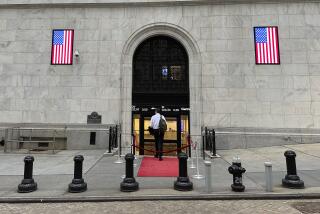Trend Zone
The outlook couldn’t have been bleaker for Intel and its stock price on June 3.
The semiconductor giant was being rocked by everything from weak personal-computer demand and falling chip prices to looming antitrust charges and investors’ fear of a second-quarter earnings warning.
Intel’s stock, which had been at $95 in February, fell almost 5% on June 3 to just below $66--and looked to many people as if it would head even lower.
But to investors using technical analysis, the picture was quite different. Technicians, as they’re known, focus not on a company’s sales and earnings trends but rather on the price and volume patterns of its stock.
What did the technicians see? They knew that the stock had fallen to a range of $65 to $68 four times in the previous 15 months, but that it had never dipped meaningfully below that.
That was a key piece of information. The fact that Intel’s stock previously had “support” at that level meant it might have it again. So an investor might have decided to buy Intel that day partly on the assumption that the drop in the stock was just about over.
As it turned out, the technicians were right. Intel recovered the June 3 loss within two days, moved sideways for a couple of weeks and has since moved up to $81.75 as of Monday.
The notion of “support” is one of several basic technical analysis tools that individual investors can use to improve their stock picking.
Technical analysis is closely identified with Wall Street pros and so-called day traders who rapidly trade in and out of stocks. But technical analysis can be just as helpful to buy-and-hold investors.
Fundamental research helps individuals decide which stocks to buy and sell. By contrast, technical analysis gives clues about when to buy and sell them. Even investors with long-term time horizons can benefit by buying or selling at the most opportune points.
*
Look at the Intel stock chart accompanying this story. It shows that before the early-June decline to the mid-to-high $60s, Intel had sagged into that range last October and again in December. Both times, the stock recovered in fairly short order and moved higher. The same pattern occurred in spring 1997.
That’s known as support: Each time the stock drops to a certain level, it’s supported by investors who jump in and buy, thus preventing the shares from falling lower.
Why do stocks find support at certain levels?
To answer that question, consider an example given by Michael Kahn, chief technical analyst at BridgeNews, a unit of Bridge Information Systems, a New York-based data company.
Imagine that an investor considered buying a stock when it traded at $50. But while the investor mulled the decision, the stock quickly skipped ahead to $70. The investor considered the stock reasonably priced at $50 but thought it overvalued at $70.
However, he continued to track it, figuring that if it ever drifted back toward $50, he would move into it.
“You have in your head that $50 is a place you should have bought it, and now you have a second chance,” Kahn said.
*
The actions of a second type of investor also create support. This group didn’t see the stock when it initially traded at $50. They did, however, see it at $70. And just like the first group, they also began watching the stock and were prepared to buy around $50.
The first two sets of investors probably used fundamental analysis. That is, after studying the company’s sales, earnings and future prospects, they decided the stock was attractively priced at $50.
Once the first two groups have acted and the stock has once or twice rebounded at $50, a third group of investors enters the scene. They’re the technically oriented investors. Having witnessed support kick in around $50 in the past, they jump in the next time it reaches that level. In effect, the dynamic of support becomes something of a self-fulfilling prophecy.
“If you think about buying a stock and it’s close to or at a support level, then your comfort level is going to be relatively high because there’s been demand at that level in the past,” said Richard Dickson, a technical analyst at Scott & Stringfellow Inc., a regional brokerage in Richmond, Va.
*
Technicians watch another indicator, known as “resistance,” that works on a principle similar to support. To understand resistance, look at the chart of Applied Materials stock.
Like Intel, Applied has recently found support at a particular level--about $26 a share, since December.
But Applied also has had a resistance level of about $40, which is depicted by the dotted line drawn near that level in the chart.
Whereas stocks often stop falling when they hit support, they often stop rising when they reach what has historically been a resistance level.
Since early November, Applied has hit resistance near $40 five times and come close a sixth time. Each time, the stock made a one- or two-day attempt at piercing $40, then fell back.
Is that simply a coincidence? Technicians would argue it isn’t.
Resistance occurs largely because a significant number of investors have bought the stock at prices around $40 or higher. They held on while the stock fell, in the hope that it would return to their buy points and give them a chance to recoup their money.
So when the shares reach that level again, more of those investors sell out, pushing the price back down. “Resistance is nothing more than ‘get me out even,’ ” Dickson said.
*
Of course, support and resistance levels aren’t written in stone. A fresh piece of news--either good or bad--can and eventually will break the pattern in time.
Thus, not surprisingly, it’s bearish when a stock drops notably below its recent support level, and it’s bullish when it slashes through its recent resistance.
In some cases, once a resistance level has been penetrated, a stock’s previous resistance will serve as a new support area.
“When you finally break through the resistance, it tells you something significant has happened,” Dickson said.
All other things being equal, a technician would rather buy Applied as it drifts back toward $26--or if it should decisively jump above $40.
Technicians caution, however, that hunting for stocks near their support levels isn’t a technique for identifying issues that are about to rocket dramatically higher. A support line indicates that a stock may stop falling, but it’s not a sign that the stock is about to soar.
More often than not, the stock is likely to remain stuck in a “trading range” between support and resistance--providing a limited profit opportunity for short-term traders.
*
Another useful technical tool is the “moving average,” depicted by the curving lines running through the accompanying stock charts.
A moving average shows the general trend in a stock’s price over a certain period. It’s calculated by tallying a stock’s daily closing prices over a certain number of days and then dividing by the number of days. The average is “moving” because a new closing stock price is added each day while the oldest figure is dropped.
In the charts, lines show the 50-day moving average and 200-day average for each stock.
Moving averages can be telling in either of two cases: when the stock price cuts through the moving average line (up or down), or when one moving average line penetrates the other.
Consider Intel. As was true of other tech companies, its stock was hit hard in October on worries that the Asian crisis would hurt earnings. Intel shares fell almost 17% that month.
But technicians would argue that the first sign of trouble came on Sept. 25, when Intel’s stock slumped below its 50-day moving average, and closed at $93.13. That was 23 trading days before the market’s big plunge of Oct. 27, when the Dow Jones industrial average lost 554 points.
An investor paying no attention to technical signs wouldn’t have spotted Intel’s weakness because the stock was simply moving sideways in late September.
By itself, Intel’s drop below its 50-day moving average line probably wasn’t a reason to sell. But a second alarm bell sounded Oct. 24, the Friday before the big market plunge.
On that day the stock slipped below its 200-day moving average line, a far more important indicator than the 50-day line. Some technicians strongly believe that stocks dropping below their 200-day lines should be sold and that those rising above them should be bought. Intel closed that day at $80.
A third negative came in December when Intel’s 50-day line broke below the 200-day line. That meant the short-term trend had worsened relative to the longer-term trend.
*
What would technicians say about Intel and Applied Materials today?
Intel has rebounded from its low, but recently has bumped up against resistance around $85.
As for Applied Materials, its support line appears solid. After the close of trading on July 10, the company warned that third-quarter earnings would fall below analyst expectations. But the stock fell only 3% the next day and has remained above its recent support level.
This article is one in an occasional series explaining basic technical analysis.
*
Times staff writer Walter Hamilton can be reached by e-mail at walter.hamilton@latimes.com.
(BEGIN TEXT OF INFOBOX / INFOGRAPHIC)
A Technician’s View of Two Tech Stocks
Here is trading activity in shares of Intel Corp. and Applied Materials Inc. over the last 12 months, including daily high, low and closing prices; daily trading volume; the stocks’ 50-day and 200-day moving average lines; and lines indicating the stocks’ key “support” and “resistance” levels.
Source: Bloomberg News






